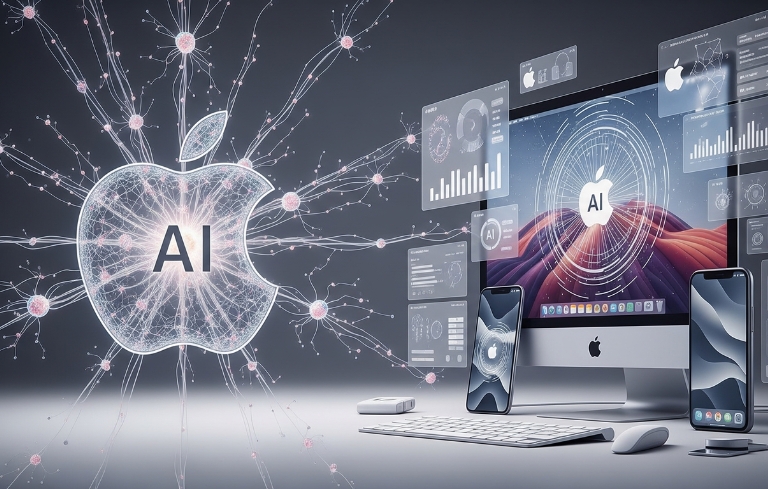Hey, tech enthusiasts and app creators! Get ready, because something big is brewing in Cupertino. It’s being reported that Apple is preparing to allow third-party developers to write software using its AI models. This isn’t just a ripple; it’s a potential tidal wave that could fundamentally change the landscape of app development on Apple devices and significantly shake up the ongoing AI race.
For years, Apple has been known for its meticulously controlled ecosystem – the “walled garden.” While this has brought incredible security and user experience, it’s also meant that developers have had limited direct access to the core technologies that power Apple’s devices. But with the rapid acceleration of artificial intelligence, it seems even Apple understands the power of collaboration. This strategic move aims to boost the creation of new applications and truly strengthen Apple’s competitive position against major rivals like Samsung and Google in the burgeoning AI space.
Why This is a Game-Changer for Developers and Users
So, why is Apple, known for its tight control, taking this step? And what does it mean for you, whether you’re a developer dreaming up the next big app or a user eager for smarter experiences? Let’s dive in.
Unleashing a New Wave of Innovation
For too long, developers building for Apple’s ecosystem have largely relied on their own AI capabilities or integrated third-party AI solutions. While powerful, this meant they couldn’t directly tap into the deeply integrated, on-device intelligence that Apple’s own applications leverage. By opening up its AI models, Apple is essentially handing developers a new set of incredibly powerful tools.
Imagine the possibilities:
- More intuitive apps: Apps that understand context better, predict user needs, and offer truly personalized experiences.
- Enhanced productivity: New tools that leverage Apple Intelligence for summarizing, drafting, and organizing information directly within third-party apps.
- Creative breakthroughs: Developers could integrate Apple’s image generation capabilities into their creative suites, leading to novel artistic tools.
This move is about fostering a vibrant developer ecosystem around AI. It’s a recognition that the collective ingenuity of millions of developers can accelerate innovation far beyond what Apple’s internal teams could achieve alone. This could lead to an explosion of AI-powered features that make our devices even smarter and more helpful in everyday life.
Boosting “Apple Intelligence” and User Adoption
Apple officially rolled out “Apple Intelligence,” its suite of AI features, with iOS 18. While impressive, a common theme in the tech world is that AI truly shines when it’s integrated seamlessly into a multitude of applications and workflows. By allowing external developers to leverage its large language models and other AI capabilities, Apple is massively increasing the surface area for Apple Intelligence to impact users.
Think about it: if your favorite note-taking app can suddenly summarize long documents using Apple’s on-device AI, or your preferred photo editor can intelligently enhance images with built-in Apple models, the value of Apple Intelligence instantly skyrockets. This strategic move could significantly increase the appeal of Apple Intelligence among both developers and users, driving greater adoption and engagement with Apple’s devices. It’s a smart play to ensure their AI isn’t just a set of isolated features, but a pervasive, integrated experience.
Intensifying the AI Arms Race: Apple vs. Samsung and Google
Let’s be frank: the AI landscape is fiercely competitive. Samsung has made significant strides with Galaxy AI, often integrating Google’s powerful Gemini models into its devices. Google, of course, is a dominant force in AI, pushing the boundaries with its own models and services. For a while, some analysts viewed Apple as playing catch-up in the generative AI space.
This decision to open its AI models to developers is a clear signal that Apple is not just participating in the AI race; it’s stepping up its game to compete more aggressively. By empowering its vast developer community to build on its proprietary AI, Apple can rapidly expand the range and sophistication of AI-powered applications available on its platforms. This could create a unique advantage, especially as Apple emphasizes on-device processing and user privacy – key differentiators that resonate with its user base. It’s about leveraging its strengths to create a unique AI experience that rivals, and perhaps even surpasses, what its competitors offer.
What Developers Should Expect
If you’re a developer, this news should have you buzzing with excitement. But what will it actually look like?
A New SDK and Frameworks
Reports suggest that Apple is working on a new software development kit (SDK) and related frameworks that will enable developers to build AI features based on the large language models that power Apple Intelligence. This will likely involve dedicated APIs and tools that allow developers to access Apple’s AI capabilities within their own applications. Expect a detailed unveiling at a future Worldwide Developers Conference (WWDC), where Apple typically lays out its developer roadmap.
Initial Focus on On-Device Models
It’s likely that Apple will initially open up access to its smaller AI models that run primarily on devices, rather than its more advanced, cloud-based models. This aligns with Apple’s strong emphasis on on-device privacy and performance. While cloud-based AI offers immense power, on-device AI provides instant responsiveness and keeps user data localized and secure. This tiered approach is a smart way to begin the rollout, allowing developers to experiment and integrate AI features while adhering to Apple’s core values.
The App Store’s AI-Powered Future
This move has significant implications for the App Store. As more developers integrate Apple’s AI, we can expect a new generation of apps that are inherently smarter, more personalized, and more efficient. This could lead to a renewed surge in app innovation, much like when Apple first opened its software frameworks to developers in the early days of the App Store. And of course, a thriving app ecosystem benefits Apple directly through its revenue share from app sales and subscriptions.
The Road Ahead: Embracing the AI Era
Apple’s reported decision to open its AI models to third-party developers is a monumental shift. It signifies a maturation in their AI strategy, moving from a more closed approach to one that embraces the power of community and collaboration. This is a win-win: developers gain access to powerful new tools, users get smarter and more capable applications, and Apple strengthens its hand in the incredibly important artificial intelligence market. As the AI landscape continues to evolve at lightning speed, this move ensures that Apple remains at the forefront of innovation, building a future where our devices don’t just respond to our commands, but truly anticipate our needs and enhance our lives in profound ways. It’s an exciting time to be an Apple user or developer – get ready for the next wave of AI-powered innovation!







